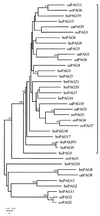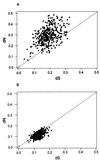Adaptive diversification within a large family of recently duplicated, placentally expressed genes
- PMID: 10725351
- PMCID: PMC16237
- DOI: 10.1073/pnas.97.7.3319
Adaptive diversification within a large family of recently duplicated, placentally expressed genes
Abstract
The pregnancy-associated glycoproteins (PAG) are putative peptide-binding proteins and products of a large family of genes whose expression is localized to the placental surface epithelium of artiodactyl species. We have tested the hypothesis that natural selection has favored diversification of these genes by examining patterns of nucleotide substitution in a sample of 28 closely related bovine, caprine, and ovine family members that are expressed only in trophoblast binucleate cells. Three observations were made. First, in codons encoding highly variable domains of the proteins, there was a greater accumulation of both synonymous and nonsynonymous mutations than in the more conserved regions of the genes. Second, in the variable regions, the mean number of nonsynonymous nucleotide substitutions per site was significantly greater than the mean number of synonymous substitutions per site. Third, nonsynonymous changes affecting amino acid charge occurred more frequently than expected under random substitution. This unusual pattern of nucleotide substitution implies that natural selection has acted to diversify these PAG molecules at the amino acid level, which in turn suggests that these molecules have undergone functional diversification. We estimate that the binucleate cell-expressed PAG originated 52 +/- 6 million years ago, soon after the divergence of the ruminant lineage. Thus, rapid functional diversification of PAG expressed in trophoblast binucleate cells seems to have been associated with the origin of this unique placental adaptation.
Figures



References
-
- Szafranska B, Xie S, Green J, Roberts R M. Biol Reprod. 1995;53:21–28. - PubMed
-
- Green J A, Xie S, Szafranska B, Gan X, Newman A G, McDowell K, Roberts R M. Biol Reprod. 1999;60:1069–1077. - PubMed
-
- Gan X, Xie S, Green J, Roberts R M. Biol Reprod. 1997;56,Suppl. 1:191. (abstr.).
-
- Chen X, Roberts R M, Green J A. Biol Reprod. 1999;60,Suppl. 1:216. (abstr.). - PubMed
Publication types
MeSH terms
Substances
Associated data
- Actions
- Actions
- Actions
- Actions
- Actions
- Actions
- Actions
- Actions
- Actions
- Actions
- Actions
- Actions
- Actions
- Actions
- Actions
- Actions
- Actions
- Actions
- Actions
- Actions
- Actions
- Actions
- Actions
- Actions
- Actions
- Actions
- Actions
- Actions
- Actions
- Actions
Grants and funding
LinkOut - more resources
Full Text Sources
Other Literature Sources
Molecular Biology Databases

